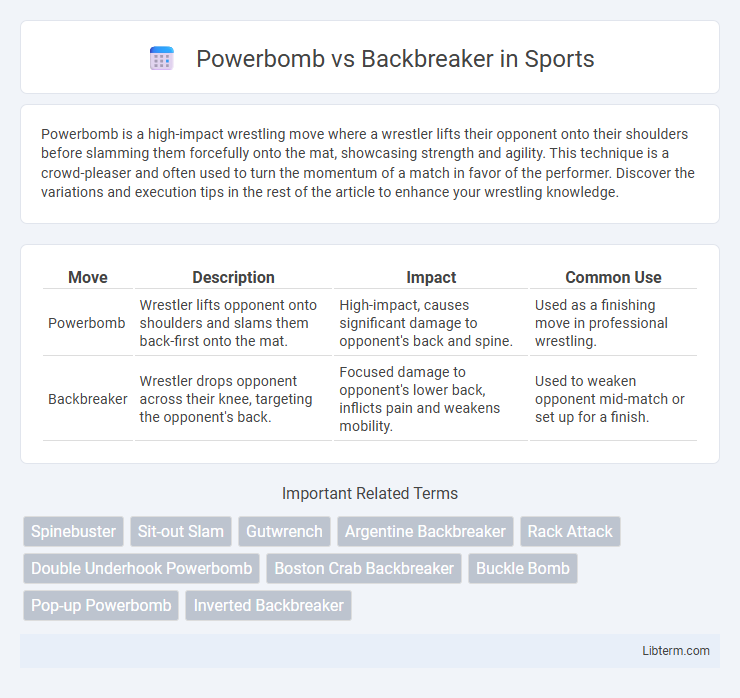Powerbomb is a high-impact wrestling move where a wrestler lifts their opponent onto their shoulders before slamming them forcefully onto the mat, showcasing strength and agility. This technique is a crowd-pleaser and often used to turn the momentum of a match in favor of the performer. Discover the variations and execution tips in the rest of the article to enhance your wrestling knowledge.
Table of Comparison
| Move | Description | Impact | Common Use |
|---|---|---|---|
| Powerbomb | Wrestler lifts opponent onto shoulders and slams them back-first onto the mat. | High-impact, causes significant damage to opponent's back and spine. | Used as a finishing move in professional wrestling. |
| Backbreaker | Wrestler drops opponent across their knee, targeting the opponent's back. | Focused damage to opponent's lower back, inflicts pain and weakens mobility. | Used to weaken opponent mid-match or set up for a finish. |
Introduction to Powerbombs and Backbreakers
Powerbombs and backbreakers are iconic wrestling moves showcasing strength and impact. A powerbomb involves lifting an opponent onto the shoulders and slamming them forcefully onto their back, emphasizing power and control. In contrast, a backbreaker targets the opponent's spine by dropping them across the performer's knee, delivering focused damage to the back area.
Historical Origins of Powerbomb and Backbreaker
The powerbomb, originating in the 1970s, was popularized by wrestling legends such as Lou Thesz and later refined by innovators like Kevin Nash, emphasizing aerial dominance and impact. The backbreaker, rooted in classic wrestling holds from the early 20th century, showcases targeted spinal attacks and was notably executed by stars like Bret Hart and Chris Jericho. Both maneuvers have evolved through decades, shaping the dynamic storytelling and physicality of modern professional wrestling.
Technique Breakdown: Powerbomb
The powerbomb technique involves lifting the opponent onto the wrestler's shoulders in a seated position before forcefully driving them down onto their back, leveraging raw strength and precise balance. Key components include securing a strong grip around the opponent's waist, maintaining a stable base, and generating upward momentum to hoist the opponent off the ground while preparing for the impactful slam. Powerbomb execution demands explosive power, timing, and control to maximize impact while minimizing injury risk.
Technique Breakdown: Backbreaker
The backbreaker technique targets an opponent's spine by lifting them onto the wrestler's shoulder before dropping them back-first onto an extended knee or the mat. This move requires precise control and timing to maximize impact while minimizing risk of injury to both wrestlers. Variations include the sitout backbreaker and butterfly backbreaker, each emphasizing different angles and force distribution to enhance effectiveness and spectacle.
Key Differences Between Powerbomb and Backbreaker
Powerbomb involves lifting an opponent onto the wrestler's shoulders before forcefully slamming them down on their back, emphasizing high-impact power and control. Backbreaker targets the opponent's spine by lifting them and dropping their back across the wrestler's knee, focusing on causing back and spinal damage. The key difference lies in the execution and impact area: Powerbomb delivers a vertical, powerful slam to the entire back, while Backbreaker applies focused pressure to the mid-back region through a bending motion.
Signature Variations and Styles
The Powerbomb features a range of signature variations including the Sitout Powerbomb, where the wrestler drops into a seated position while driving the opponent down, and the Jackknife Powerbomb, involving a twist that lands the opponent back-first. The Backbreaker showcases diverse styles such as the Argentine Backbreaker, in which the wrestler lifts and drops the opponent across the shoulder, and the Backbreaker Rack, involving a sustained hold with pressure applied to the opponent's back. These variations emphasize different dynamics of power and leverage, adapting the core techniques to the wrestler's unique style and audience impact.
Notable Wrestlers Who Utilize Each Move
Notable wrestlers who utilize the powerbomb include Kevin Nash, Batista, and The Undertaker, known for their iconic variations such as the Jackknife Powerbomb and the Sitout Powerbomb. Meanwhile, the backbreaker is famously employed by Chris Jericho and Shawn Michaels, with moves like the Backbreaker Drop and the Swinging Backbreaker enhancing their in-ring offense. Both maneuvers serve as signature finishing moves that showcase strength and technical skill in professional wrestling.
Impact and Effectiveness in the Ring
The Powerbomb delivers a high-impact maneuver by lifting the opponent vertically and forcefully slamming them onto their back, maximizing damage through sheer force and elevation. In contrast, the Backbreaker targets the opponent's spine and ribs, emphasizing precision and pain by collapsing their back over the attacker's knee. While the Powerbomb is visually spectacular and often match-ending, the Backbreaker's effectiveness lies in weakening the opponent's core, leading to prolonged damage and strategic control within the ring.
Audience Reactions and Spectacle Factor
Powerbombs ignite explosive crowd reactions with their high-impact nature and dramatic elevation, generating intense excitement and anticipation among fans. Backbreakers captivate the audience through the visual spectacle of a wrestler theatrically crashing opponents' backs onto their knees, eliciting visceral responses and pain empathy. The raw power and dynamic motion of powerbombs often create a more electrifying spectacle, while backbreakers emphasize technical brutality that resonates with hardcore wrestling enthusiasts.
Powerbomb vs Backbreaker: Which is More Dominant?
The Powerbomb showcases immense dominance by lifting and slamming an opponent onto their back, symbolizing raw power and control in professional wrestling. In contrast, the Backbreaker targets the spine and ribs, emphasizing technical precision and inflicting focused pain rather than sheer force. Evaluating dominance, the Powerbomb typically appears more overpowering due to its high-impact nature and dramatic visual effect.
Powerbomb Infographic

 libterm.com
libterm.com